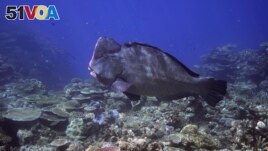24 September 2023
Australia's government has placed sensors in parts of the Great Barrier Reef in an effort to record water quality.
The Great Barrier Reef covers about 344,000 square kilometers of area off Australia's northeast coast. It contains hundreds of islands and thousands of natural structures, known as reefs.
The sensors measure levels of sediment and carbon materials flowing from the Fitzroy River into Keppel Bay in Queensland state. The area sits within the southern part of the Great Barrier Reef. Such substances can damage sea life.

A bumphead parrotfish swims above corals on Moore Reef in Gunggandji Sea Country off the coast of Queensland in eastern Australia on Nov. 13, 2022. (AP Photo/Sam McNeil)
The Australian government agency Commonwealth Scientific and Industrial Research Organization (CSIRO) operates the program. The agency says the effort uses the sensors and satellite data to measure changes in water quality.
Experts say the quality of Australia's coastal and inland waterways is being threatened by warming temperatures, urbanization, deforestation and pollution.
The reef is one of seven test areas of CSIRO's AquaWatch Australia Mission. The research team hopes to establish 15 testing areas by 2026.
Alex Held leads the program. He told VOA that sediments can be harmful to ocean life because they can block sunlight from the seafloor. The lack of sunlight can hurt the growth of sea plants and other organisms. Sediments can also settle on the tops of coral reefs, affecting sea life there as well.
Held said the sensors and satellites will be used to measure the effectiveness of programs meant to reduce the flow, or runoff, of river sediment into the sea.
Held noted that the Australian government already operates a series of programs aimed at reducing the effects of sediments on sea life. These include efforts to keep plants growing along riverbeds and other bodies of water to help keep sediments out.
Environmentalists have warned that the Great Barrier Reef faces a number of threats. These include climate change, pollution and runoff of agricultural products. The reef – which runs about 2,300 kilometers – has been on the United Nations World Heritage List since 1981.
I'm Bryan Lynn.
Phil Mercer reported this story for VOA News. Bryan Lynn adapted the report for Learning English.
______________________________________________
Words in This Story
sediment – n. materials that collect at the bottom of a liquid
urbanization – n. the process by which more and more people leave the countryside to live in cities
coral – n. a hard, usually pink or white substance produced by a type of very small sea animal